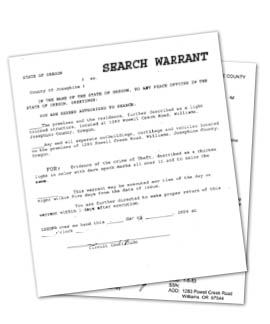Archival Notice
This is an archive page that is no longer being updated. It may contain outdated information and links may no longer function as originally intended.
Home | Glossary | Resources | Help | Contact Us | Course Map
In Schmerber v. California, 384 U.S. 757; 86 S.Ct. 1826; 16 L. Ed.2d 908 (1966), superseded by statute, 625 ILL. COMP. STAT. 5/11-501.2 (1995), as recognized in People v. Jones, 800 N.E.2d 1227; 344 Ill. App.3d 684; 279 Ill. Dec. 644 (Ill App. Ct. 2003), the Court established that the 4th Amendment applies to removing material from a suspect's body. Generally, in order to obtain a search warrant to collect a DNA sample from a suspect, a judge must be persuaded that probable cause exists and that the sought-after DNA sample will produce evidence linking the suspect to the crime being investigated.
The extent of the intrusion needed to secure the biological sample must be considered. Typically, collecting blood, hair, or body swabs will not violate an individual's constitutional rights since the nature of the collection is not substantially invasive. However, if law enforcement believes a suspect will be uncooperative in providing a sample, a judge may authorize the use of a reasonable amount of force to extract the biological material U.S. v. Bullock, 71 F.3d 171 (5th Cir. 1995)].
In some jurisdictions (See Ariz. Rev. Stat. Ann. 13-3905), and based on dicta in Davis v. Mississippi (394 U.S. 721; 89 S.Ct. 1394; 22 L.Ed. 2d 676 (1969)) and Hayes v. Florida ((1985)), an order may be issued on reasonable suspicion. Other states have used a process called "investigative detention," which allows a warrant to be issued on a "reasonable and well-grounded basis" to believe a person "may have" committed a crime.
Additional Online Courses
- What Every First Responding Officer Should Know About DNA Evidence
- Collecting DNA Evidence at Property Crime Scenes
- DNA – A Prosecutor’s Practice Notebook
- Crime Scene and DNA Basics
- Laboratory Safety Programs
- DNA Amplification
- Population Genetics and Statistics
- Non-STR DNA Markers: SNPs, Y-STRs, LCN and mtDNA
- Firearms Examiner Training
- Forensic DNA Education for Law Enforcement Decisionmakers
- What Every Investigator and Evidence Technician Should Know About DNA Evidence
- Principles of Forensic DNA for Officers of the Court
- Law 101: Legal Guide for the Forensic Expert
- Laboratory Orientation and Testing of Body Fluids and Tissues
- DNA Extraction and Quantitation
- STR Data Analysis and Interpretation
- Communication Skills, Report Writing, and Courtroom Testimony
- Español for Law Enforcement
- Amplified DNA Product Separation for Forensic Analysts


